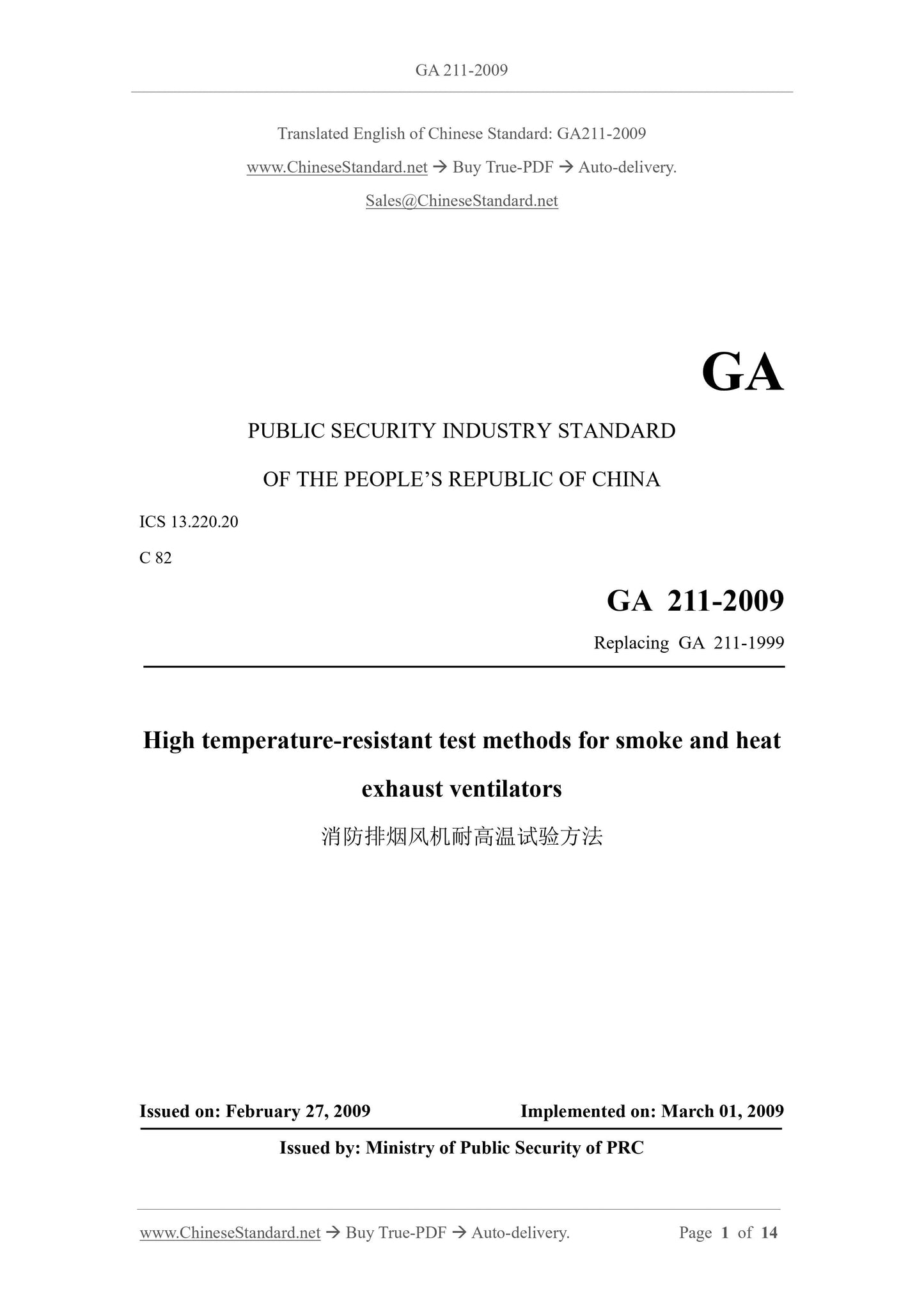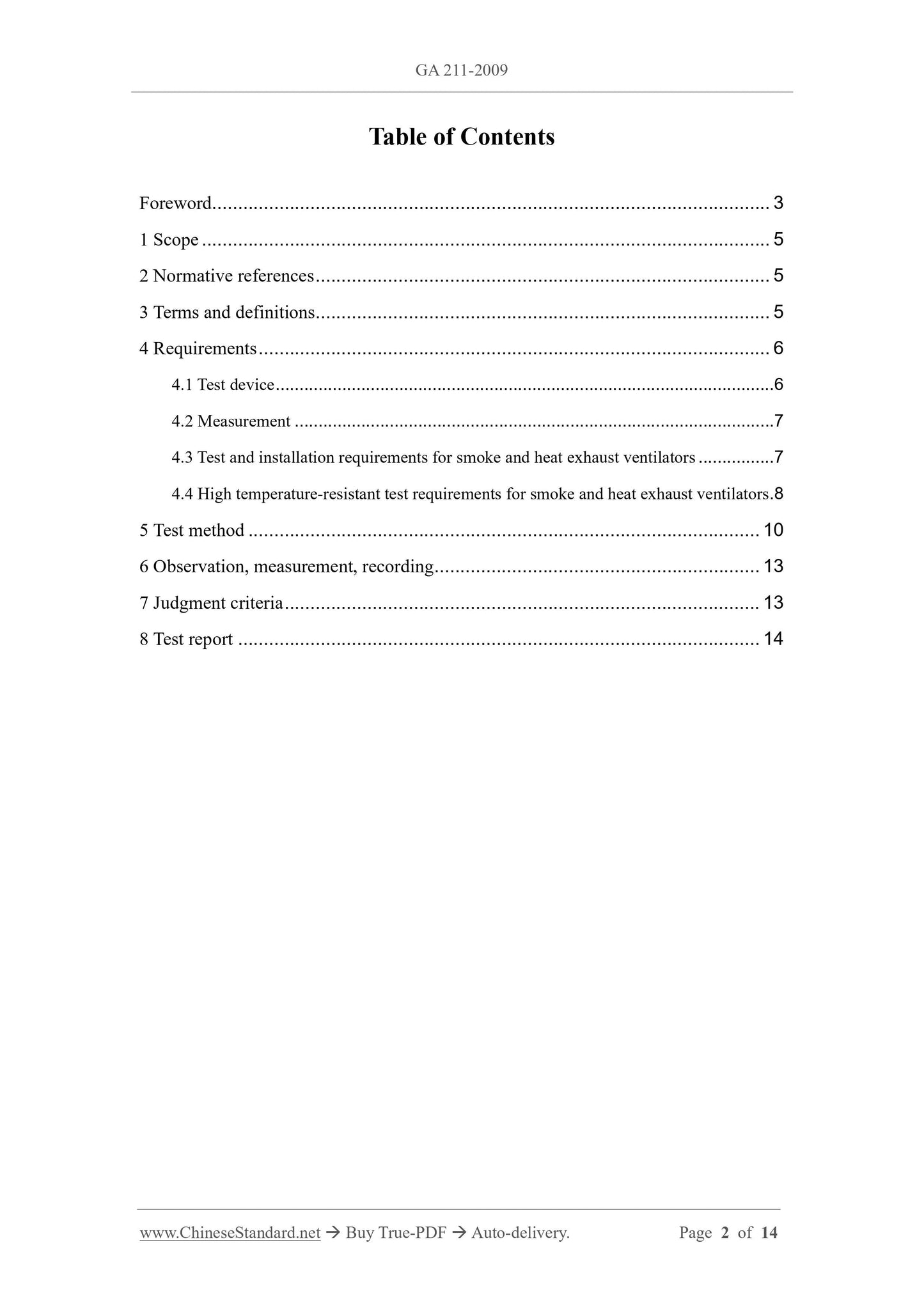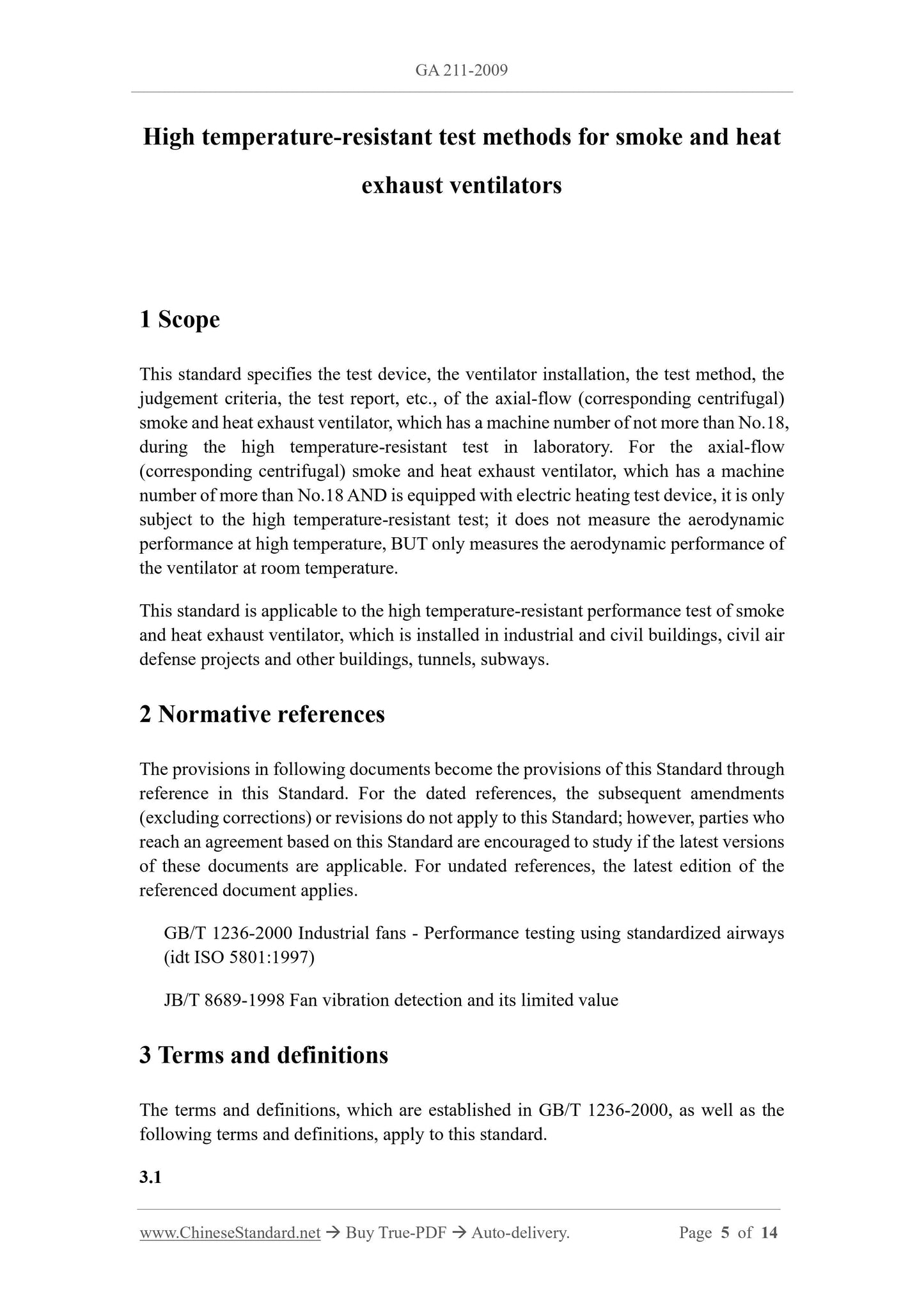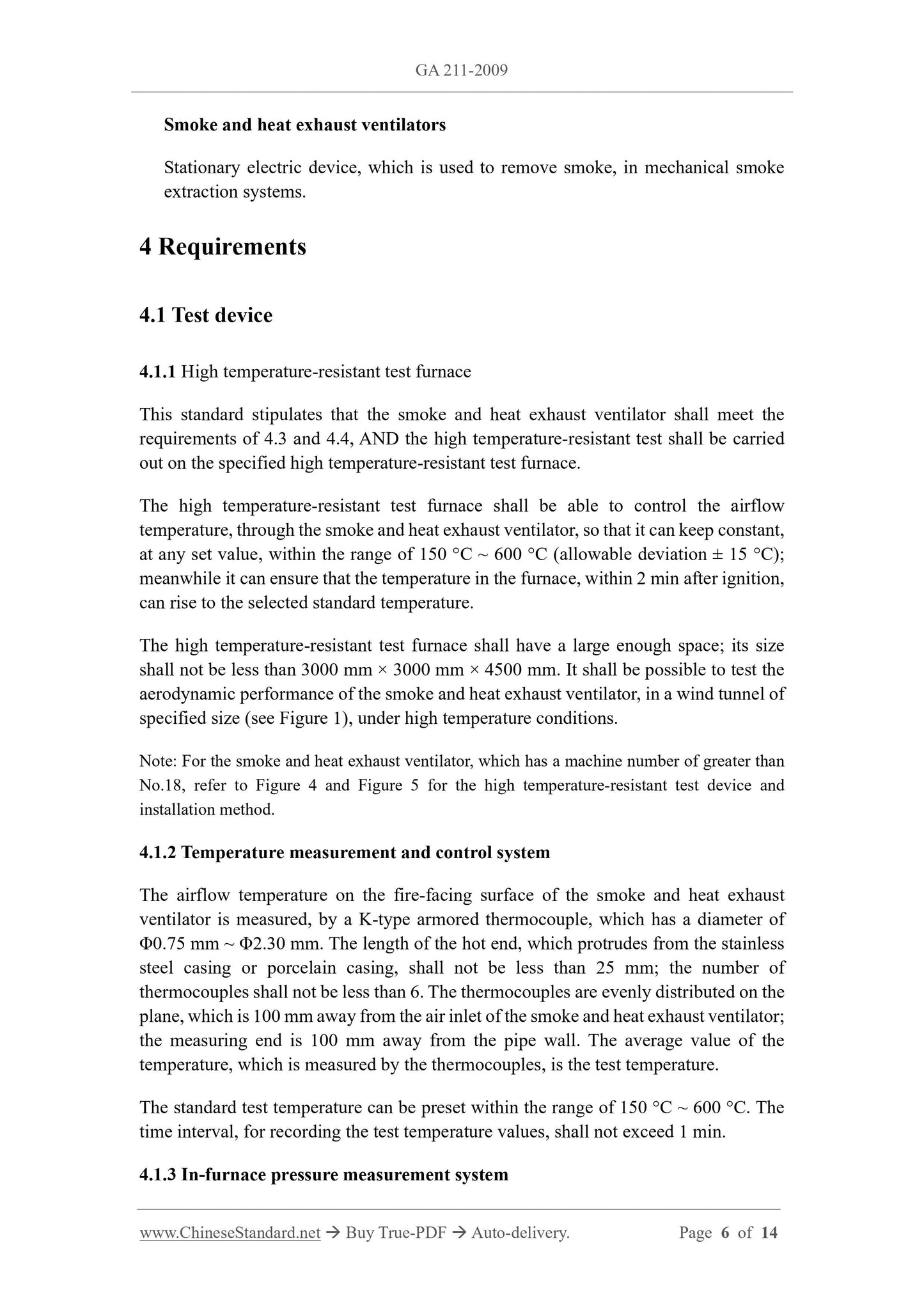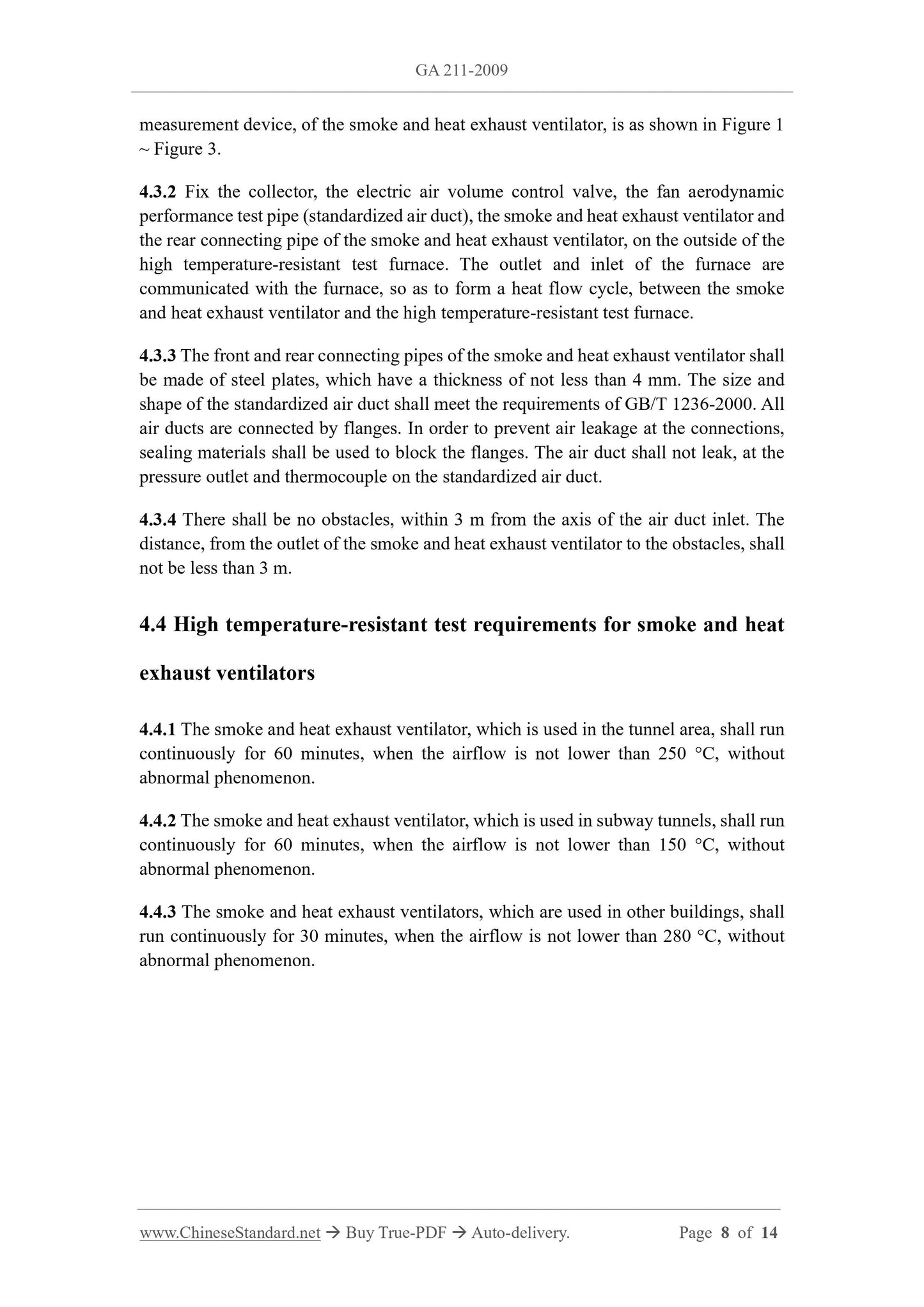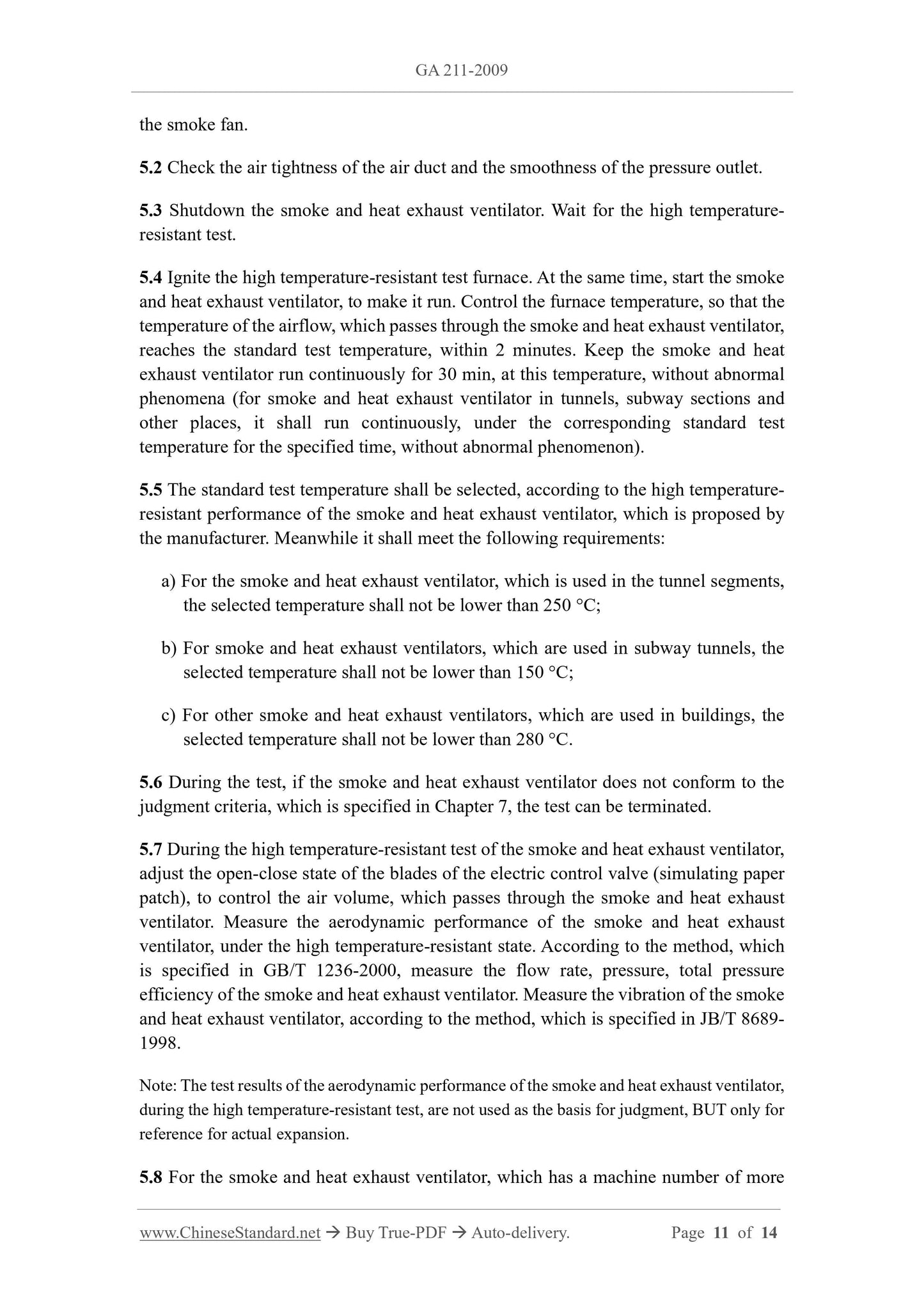1
/
von
6
PayPal, credit cards. Download editable-PDF and invoice in 1 second!
GA 211-2009 English PDF (GA211-2009)
GA 211-2009 English PDF (GA211-2009)
Normaler Preis
$160.00 USD
Normaler Preis
Verkaufspreis
$160.00 USD
Grundpreis
/
pro
Versand wird beim Checkout berechnet
Verfügbarkeit für Abholungen konnte nicht geladen werden
Delivery: 3 seconds. Download true-PDF + Invoice.
Get QUOTATION in 1-minute: Click GA 211-2009
Historical versions: GA 211-2009
Preview True-PDF (Reload/Scroll if blank)
GA 211-2009: High temperature-resistant test methods for smoke and heat exhaust ventilators
GA 211-2009
PUBLIC SECURITY INDUSTRY STANDARD
OF THE PEOPLE’S REPUBLIC OF CHINA
ICS 13.220.20
C 82
Replacing GA 211-1999
High temperature-resistant test methods for smoke and heat
exhaust ventilators
ISSUED ON: FEBRUARY 27, 2009
IMPLEMENTED ON: MARCH 01, 2009
Issued by: Ministry of Public Security of PRC
Table of Contents
Foreword ... 3
1 Scope ... 5
2 Normative references ... 5
3 Terms and definitions... 5
4 Requirements ... 6
4.1 Test device ... 6
4.2 Measurement ... 7
4.3 Test and installation requirements for smoke and heat exhaust ventilators ... 7
4.4 High temperature-resistant test requirements for smoke and heat exhaust ventilators . 8
5 Test method ... 10
6 Observation, measurement, recording ... 13
7 Judgment criteria ... 13
8 Test report ... 14
High temperature-resistant test methods for smoke and heat
exhaust ventilators
1 Scope
This standard specifies the test device, the ventilator installation, the test method, the
judgement criteria, the test report, etc., of the axial-flow (corresponding centrifugal)
smoke and heat exhaust ventilator, which has a machine number of not more than No.18,
during the high temperature-resistant test in laboratory. For the axial-flow
(corresponding centrifugal) smoke and heat exhaust ventilator, which has a machine
number of more than No.18 AND is equipped with electric heating test device, it is only
subject to the high temperature-resistant test; it does not measure the aerodynamic
performance at high temperature, BUT only measures the aerodynamic performance of
the ventilator at room temperature.
This standard is applicable to the high temperature-resistant performance test of smoke
and heat exhaust ventilator, which is installed in industrial and civil buildings, civil air
defense projects and other buildings, tunnels, subways.
2 Normative references
The provisions in following documents become the provisions of this Standard through
reference in this Standard. For the dated references, the subsequent amendments
(excluding corrections) or revisions do not apply to this Standard; however, parties who
reach an agreement based on this Standard are encouraged to study if the latest versions
of these documents are applicable. For undated references, the latest edition of the
referenced document applies.
GB/T 1236-2000 Industrial fans - Performance testing using standardized airways
(idt ISO 5801:1997)
JB/T 8689-1998 Fan vibration detection and its limited value
3 Terms and definitions
The terms and definitions, which are established in GB/T 1236-2000, as well as the
following terms and definitions, apply to this standard.
3.1
Smoke and heat exhaust ventilators
Stationary electric device, which is used to remove smoke, in mechanical smoke
extraction systems.
4 Requirements
4.1 Test device
4.1.1 High temperature-resistant test furnace
This standard stipulates that the smoke and heat exhaust ventilator shall meet the
requirements of 4.3 and 4.4, AND the high temperature-resistant test shall be carried
out on the specified high temperature-resistant test furnace.
The high temperature-resistant test furnace shall be able to control the airflow
temperature, through the smoke and heat exhaust ventilator, so that it can keep constant,
at any set value, within the range of 150 °C ~ 600 °C (allowable deviation ± 15 °C);
meanwhile it can ensure that the temperature in the furnace, within 2 min after ignition,
can rise to the selected standard temperature.
The high temperature-resistant test furnace shall have a large enough space; its size
shall not be less than 3000 mm × 3000 mm × 4500 mm. It shall be possible to test the
aerodynamic performance of the smoke and heat exhaust ventilator, in a wind tunnel of
specified size (see Figure 1), under high temperature conditions.
Note: For the smoke and heat exhaust ventilator, which has a machine number of greater than
No.18, refer to Figure 4 and Figure 5 for the high temperature-resistant test device and
installation method.
4.1.2 Temperature measurement and control system
The airflow temperature on the fire-facing surface of the smoke and heat exhaust
ventilator is measured, by a K-type armored thermocouple, which has a diameter of
Φ0.75 mm ~ Φ2.30 mm. The length of the hot end, which protrudes from the stainless
steel casing or porcelain casing, shall not be less than 25 mm; the number of
thermocouples shall not be less than 6. The thermocouples are evenly distributed on the
plane, which is 100 mm away from the air inlet of the smoke and heat exhaust ventilator;
the measuring end is 100 mm away from the pipe wall. The average value of the
temperature, which is measured by the thermocouples, is the test temperature.
The standard test temperature can be preset within the range of 150 °C ~ 600 °C. The
time interval, for recording the test temperature values, shall not exceed 1 min.
4.1.3 In-furnace pressure measurement system
measurement device, of the smoke and heat exhaust ventilator, is as shown in Figure 1
~ Figure 3.
4.3.2 Fix the collector, the electric air volume control valve, the fan aerodynamic
performance test pipe (standardized air duct), the smoke and heat exhaust ventilator and
the rear connecting pipe of the smoke and heat exhaust ventilator, on the outside of the
high temperature-resistant test furnace. The outlet and inlet of the furnace are
communicated with the furnace, so as to form a heat flow cycle, between the smoke
and heat exhaust ventilator and the high temperature-resistant test furnace.
4.3.3 The front and rear connecting pipes of the smoke and heat exhaust ventilator shall
be made of steel plates, which have a thickness of not less than 4 mm. The size and
shape of the standardized air duct shall meet the requirements of GB/T 1236-2000. All
air ducts are connected by flanges. In order to prevent air leakage at the connections,
sealing materials shall be used to block the flanges. The air duct shall not leak, at the
pressure outlet and thermocouple on the standardized air duct.
4.3.4 There shall be no obstacles, within 3 m from the axis of the air duct inlet. The
distance, from the outlet of the smoke and heat exhaust ventilator to the obstacles, shall
not be less than 3 m.
4.4 High temperature-resistant test requirements for smoke and heat
exhaust ventilators
4.4.1 The smoke and heat exhaust ventilator, which is used in the tunnel area, shall run
continuously for 60 minutes, when the airflow is not lower than 250 °C, without
abnormal phenomenon.
4.4.2 The smoke and heat exhaust ventilator, which is used in subway tunnels, shall run
continuously for 60 minutes, when the airflow is not lower than 150 °C, without
abnormal phenomenon.
4.4.3 The smoke and heat exhaust ventilators, which are used in other buildings, shall
run continuously for 30 minutes, when the airflow is not lower than 280 °C, without
abnormal phenomenon.
the smoke fan.
5.2 Check the air tightness of the air duct and the smoothness of the pressure outlet.
5.3 Shutdown the smoke and heat exhaust ventilator. Wait for the high temperature-
resistant test.
5.4 Ignite the high temperature-resistant test furnace. At the same time, start the smoke
and heat exhaust ventilator, to make it run. Control the furnace temperature, so that the
temperature of the airflow, which passes through the smoke and heat exhaust ventilator,
reaches the standard test temperature, within 2 minutes....
Get QUOTATION in 1-minute: Click GA 211-2009
Historical versions: GA 211-2009
Preview True-PDF (Reload/Scroll if blank)
GA 211-2009: High temperature-resistant test methods for smoke and heat exhaust ventilators
GA 211-2009
PUBLIC SECURITY INDUSTRY STANDARD
OF THE PEOPLE’S REPUBLIC OF CHINA
ICS 13.220.20
C 82
Replacing GA 211-1999
High temperature-resistant test methods for smoke and heat
exhaust ventilators
ISSUED ON: FEBRUARY 27, 2009
IMPLEMENTED ON: MARCH 01, 2009
Issued by: Ministry of Public Security of PRC
Table of Contents
Foreword ... 3
1 Scope ... 5
2 Normative references ... 5
3 Terms and definitions... 5
4 Requirements ... 6
4.1 Test device ... 6
4.2 Measurement ... 7
4.3 Test and installation requirements for smoke and heat exhaust ventilators ... 7
4.4 High temperature-resistant test requirements for smoke and heat exhaust ventilators . 8
5 Test method ... 10
6 Observation, measurement, recording ... 13
7 Judgment criteria ... 13
8 Test report ... 14
High temperature-resistant test methods for smoke and heat
exhaust ventilators
1 Scope
This standard specifies the test device, the ventilator installation, the test method, the
judgement criteria, the test report, etc., of the axial-flow (corresponding centrifugal)
smoke and heat exhaust ventilator, which has a machine number of not more than No.18,
during the high temperature-resistant test in laboratory. For the axial-flow
(corresponding centrifugal) smoke and heat exhaust ventilator, which has a machine
number of more than No.18 AND is equipped with electric heating test device, it is only
subject to the high temperature-resistant test; it does not measure the aerodynamic
performance at high temperature, BUT only measures the aerodynamic performance of
the ventilator at room temperature.
This standard is applicable to the high temperature-resistant performance test of smoke
and heat exhaust ventilator, which is installed in industrial and civil buildings, civil air
defense projects and other buildings, tunnels, subways.
2 Normative references
The provisions in following documents become the provisions of this Standard through
reference in this Standard. For the dated references, the subsequent amendments
(excluding corrections) or revisions do not apply to this Standard; however, parties who
reach an agreement based on this Standard are encouraged to study if the latest versions
of these documents are applicable. For undated references, the latest edition of the
referenced document applies.
GB/T 1236-2000 Industrial fans - Performance testing using standardized airways
(idt ISO 5801:1997)
JB/T 8689-1998 Fan vibration detection and its limited value
3 Terms and definitions
The terms and definitions, which are established in GB/T 1236-2000, as well as the
following terms and definitions, apply to this standard.
3.1
Smoke and heat exhaust ventilators
Stationary electric device, which is used to remove smoke, in mechanical smoke
extraction systems.
4 Requirements
4.1 Test device
4.1.1 High temperature-resistant test furnace
This standard stipulates that the smoke and heat exhaust ventilator shall meet the
requirements of 4.3 and 4.4, AND the high temperature-resistant test shall be carried
out on the specified high temperature-resistant test furnace.
The high temperature-resistant test furnace shall be able to control the airflow
temperature, through the smoke and heat exhaust ventilator, so that it can keep constant,
at any set value, within the range of 150 °C ~ 600 °C (allowable deviation ± 15 °C);
meanwhile it can ensure that the temperature in the furnace, within 2 min after ignition,
can rise to the selected standard temperature.
The high temperature-resistant test furnace shall have a large enough space; its size
shall not be less than 3000 mm × 3000 mm × 4500 mm. It shall be possible to test the
aerodynamic performance of the smoke and heat exhaust ventilator, in a wind tunnel of
specified size (see Figure 1), under high temperature conditions.
Note: For the smoke and heat exhaust ventilator, which has a machine number of greater than
No.18, refer to Figure 4 and Figure 5 for the high temperature-resistant test device and
installation method.
4.1.2 Temperature measurement and control system
The airflow temperature on the fire-facing surface of the smoke and heat exhaust
ventilator is measured, by a K-type armored thermocouple, which has a diameter of
Φ0.75 mm ~ Φ2.30 mm. The length of the hot end, which protrudes from the stainless
steel casing or porcelain casing, shall not be less than 25 mm; the number of
thermocouples shall not be less than 6. The thermocouples are evenly distributed on the
plane, which is 100 mm away from the air inlet of the smoke and heat exhaust ventilator;
the measuring end is 100 mm away from the pipe wall. The average value of the
temperature, which is measured by the thermocouples, is the test temperature.
The standard test temperature can be preset within the range of 150 °C ~ 600 °C. The
time interval, for recording the test temperature values, shall not exceed 1 min.
4.1.3 In-furnace pressure measurement system
measurement device, of the smoke and heat exhaust ventilator, is as shown in Figure 1
~ Figure 3.
4.3.2 Fix the collector, the electric air volume control valve, the fan aerodynamic
performance test pipe (standardized air duct), the smoke and heat exhaust ventilator and
the rear connecting pipe of the smoke and heat exhaust ventilator, on the outside of the
high temperature-resistant test furnace. The outlet and inlet of the furnace are
communicated with the furnace, so as to form a heat flow cycle, between the smoke
and heat exhaust ventilator and the high temperature-resistant test furnace.
4.3.3 The front and rear connecting pipes of the smoke and heat exhaust ventilator shall
be made of steel plates, which have a thickness of not less than 4 mm. The size and
shape of the standardized air duct shall meet the requirements of GB/T 1236-2000. All
air ducts are connected by flanges. In order to prevent air leakage at the connections,
sealing materials shall be used to block the flanges. The air duct shall not leak, at the
pressure outlet and thermocouple on the standardized air duct.
4.3.4 There shall be no obstacles, within 3 m from the axis of the air duct inlet. The
distance, from the outlet of the smoke and heat exhaust ventilator to the obstacles, shall
not be less than 3 m.
4.4 High temperature-resistant test requirements for smoke and heat
exhaust ventilators
4.4.1 The smoke and heat exhaust ventilator, which is used in the tunnel area, shall run
continuously for 60 minutes, when the airflow is not lower than 250 °C, without
abnormal phenomenon.
4.4.2 The smoke and heat exhaust ventilator, which is used in subway tunnels, shall run
continuously for 60 minutes, when the airflow is not lower than 150 °C, without
abnormal phenomenon.
4.4.3 The smoke and heat exhaust ventilators, which are used in other buildings, shall
run continuously for 30 minutes, when the airflow is not lower than 280 °C, without
abnormal phenomenon.
the smoke fan.
5.2 Check the air tightness of the air duct and the smoothness of the pressure outlet.
5.3 Shutdown the smoke and heat exhaust ventilator. Wait for the high temperature-
resistant test.
5.4 Ignite the high temperature-resistant test furnace. At the same time, start the smoke
and heat exhaust ventilator, to make it run. Control the furnace temperature, so that the
temperature of the airflow, which passes through the smoke and heat exhaust ventilator,
reaches the standard test temperature, within 2 minutes....
Share
